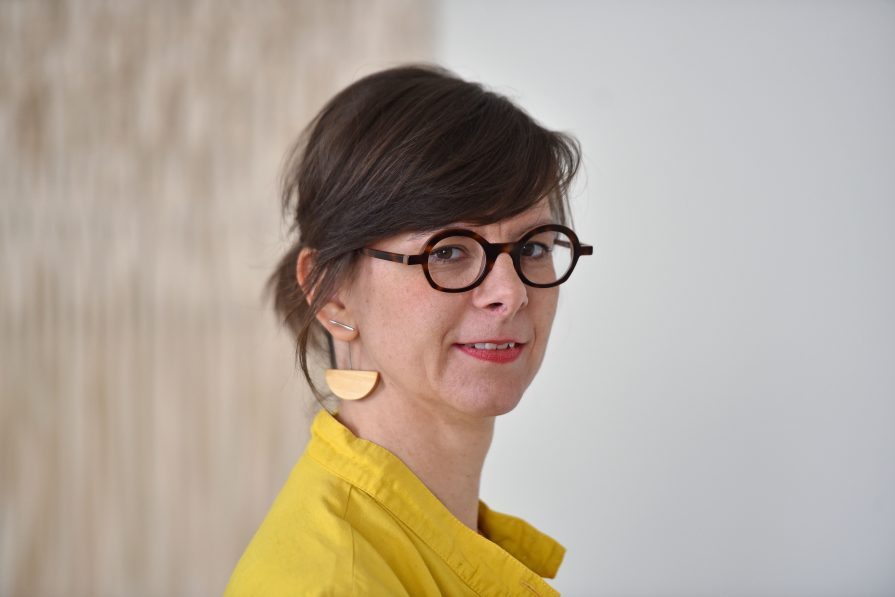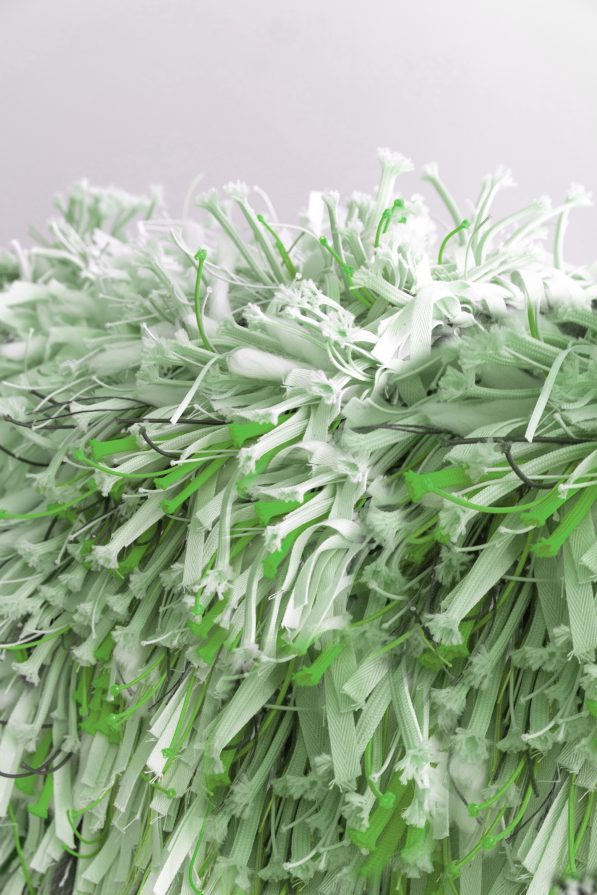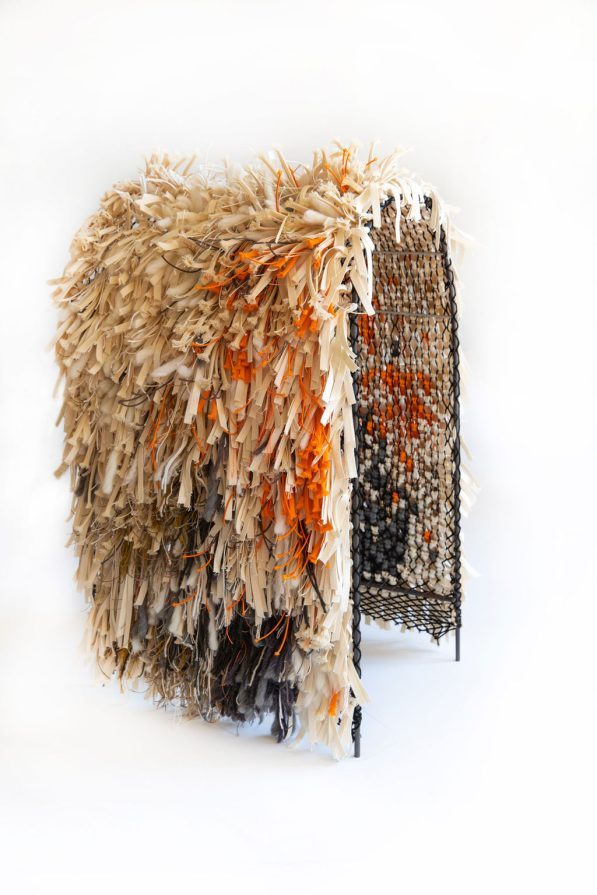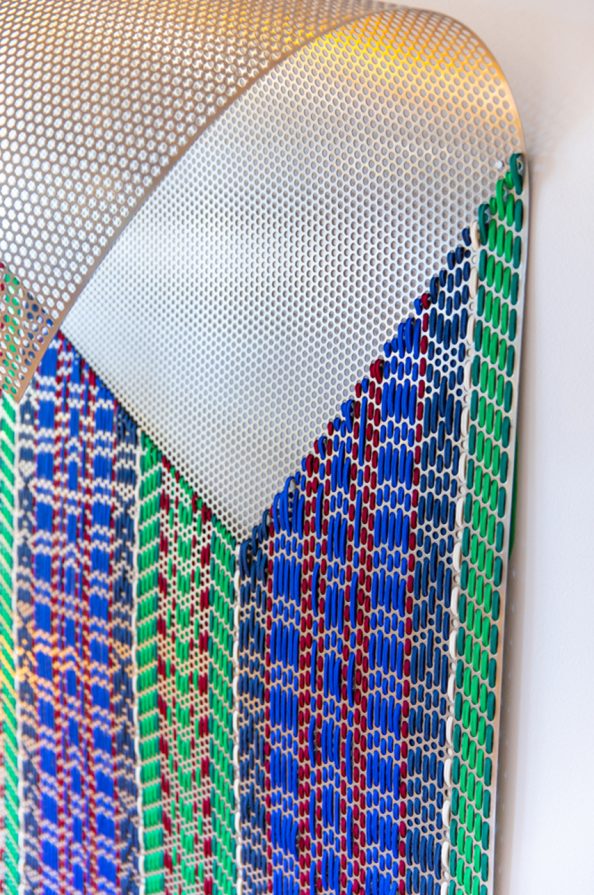SS 25: Color Conversation with Jeanne Goutelle The
An alchemist of materials and colors, Jeanne Goutelle with her singular approach to upcycling gives a second lease of life to production scraps. The designer transforms and sublimates deadstock recuperated from textile accessory factories to revalorize them.
She dreams up pieces at the crossroads of art, craft and design, interweaving heterogeneous materials, such as ribbons, straps, ropes, cords, laces, bias bindings and serpentines, specializing in “narrow textiles” from the world of trimmings and narrow woven fabrics. She braids, knots, weaves and intertwines them into shapes and textures featuring unique colors, creating flat or three-dimensional pieces. Her works become paintings, panels, sculptures and screens.

After graduating with a DMA (Diplôme de Métiers d’Art) in textiles from the Duperré School of Applied Arts in Paris, with a specialization in tapestry, Jeanne Goutelle worked for a trend forecasting agency before becoming an independent consultant. In 2017, she decided to settle in the textile industry area of Saint-Étienne from where she originally came. It was from here that she began her project based on reused textiles. Today, Jeanne Goutelle specializes in private commissions – for architects, interior designers, brands and institutions – along with producing personal artwork.
What inspired you to create your reused textiles project?
I was working on a collection of knitted accessories and was visiting a knitting factory in Roanne where I spotted a huge skip filled with cones of yarn. The manufacturer explained to me that his production surpluses were piling up, and that he was eventually going to throw the material away. The quantities were so great that I realized there existed a second-hand industry for raw materials for textiles. I decided that I was going to create things using these surplus materials, to add value to them and make people forget that they were once waste. My aim is to get people to focus on the aesthetics of the final piece before asking where the material came from.
Where do you source your raw materials from today?
I source it mainly from a manufacturer specializing in ‘narrow textiles’ in Saint-Étienne as well as from a dozen other suppliers in the region. They allow me to come and pick from whatever has been discarded, such as production errors or surplus materials. In fact, to date, there are still no regulations on this ‘finished’ woven raw material, which is often destroyed, whereas manufactured ‘finished’ products are finally being regulated.

Do you have a library of materials and colors?
I have a ‘materials library’ that I’ve built up over the years. My supplies are very particular because they are very irregular, and are based on what I find on-site. The available stock is always random. I then take what I’ve collected to my workshop, where I make an inventory of the material and store it. This circuit is part of my creative process; it’s a process of reflection, a path that begins before I start working with the material. I source according to my orders and the envisaged color range, but I also proceed in a more spontaneous way: I often let myself be surprised by what I find, which can spark new ideas.
How do you classify your raw materials?
My library is classified according to the type, size and color of the materials. I currently have over 3,500 references listed. I can have 250 meters of ribbon or sometimes more than 6,000 meters of laces at my disposal…. I don’t just collect a few centimeters here and there; I collect whole reels.
How does working with deadstock affect your creative work?
I’ve learnt to work around constraints. I work on the basis of what already exists, and the specifications that have already been drawn up, of course, but then I organize my findings in my own way. My stock of materials is non-renewable, which means I can’t re-use a particular reference, so you have to keep that in mind. Then, the color range is dictated by my discoveries. I may run out of certain colors – some are more difficult to collect, like yellow and green, even if the ranges are quite extensive overall. Textile accessories are considered fantasy items, so there’s quite a lot of choice.
On the other hand, I’m also recuperating more and more organic cotton and paper fiber scraps – sustainable materials that used to be quite marginal. These materials have a natural color, which is a new element to take into account. I integrate all this into my creative process, which I also have to explain to my clients. I can’t deliver an extremely precise idea; I’m constantly adapting. I’m like a weaver without a loom, working according to my discoveries.
What inspires you?
In Saint-Étienne, there’s a wonderful library in the Musée d’Art et d’Industrie with old manuals detailing elaborate weaving techniques for trimmings and narrow woven fabrics. It’s a real source of inspiration for me. The weave patterns and weaving structures are infinite. It’s a way of bringing forgotten skills back into fashion.
What are the different craft techniques you use to interweave materials?
Weaving, braiding and knotting. I use one tool, the crochet hook, for a certain type of knot. I can create supersized passementeries with trimmings that I’ve collected, using scoubidou techniques, based on relatively simple weaving methods that play on superimpositions of colors and materials. I create works in volume, covering metal objects or structures with materials. Materials, colors and techniques harmoniously intertwine. I also like to go back to my first love: tapestry from the Middle Ages. You need a lot of patience for these creations, which I’m certainly not short of!

Do you transform the material you collect?
No, not as such. I transform it through my combinations and interweavings. I create palettes of shades using several colors. The tones also vary according to the materials that are interwoven, their shine, texture, thickness and so on. The palette is vast, and can be expanded by superimposing different colors in different doses.
What is your personal relationship with color?
My approach to color is mainly intuitive. In fact, it’s something that inspires me a lot, like materials and techniques, everything I have in my hands. Initially, color comes from a very spontaneous desire, but I’m quickly overtaken by rational constraints, notably related to the demands of my customers and their respective universes. If it’s a one-off piece, created with an artistic approach, I’m much freer to dream up color combinations.

Are your tastes in colors changing?
Yes, absolutely. My work is traditionally made up of gradients, but I’ve noticed that I’m becoming more radical in my choices now, opting for sharper, more contrasting colors that are less tone on tone.
How do you create your color harmonies?
I don’t work according to a specific Pantone code, it’s more about an atmosphere, a color mood, and then I draw on my ‘materials library.’ For a project, I have at least fifteen color references. I feel closer to painting than sculpture, I work with layers like a painter applies layers of oil paint. I create a background with a color that is either very subdued or very dominant. Little by little, I add in colors and create layers. In this way, I create landscapes and reliefs, and the color is transformed into three dimensions.
